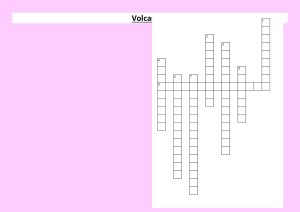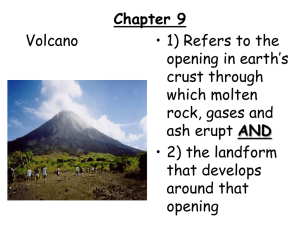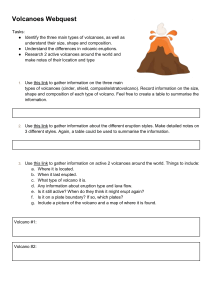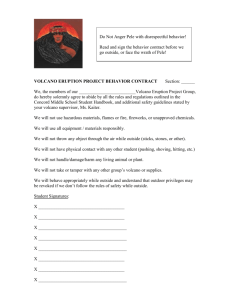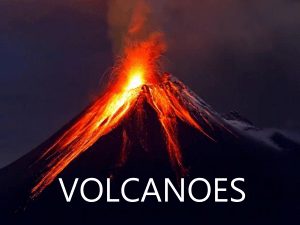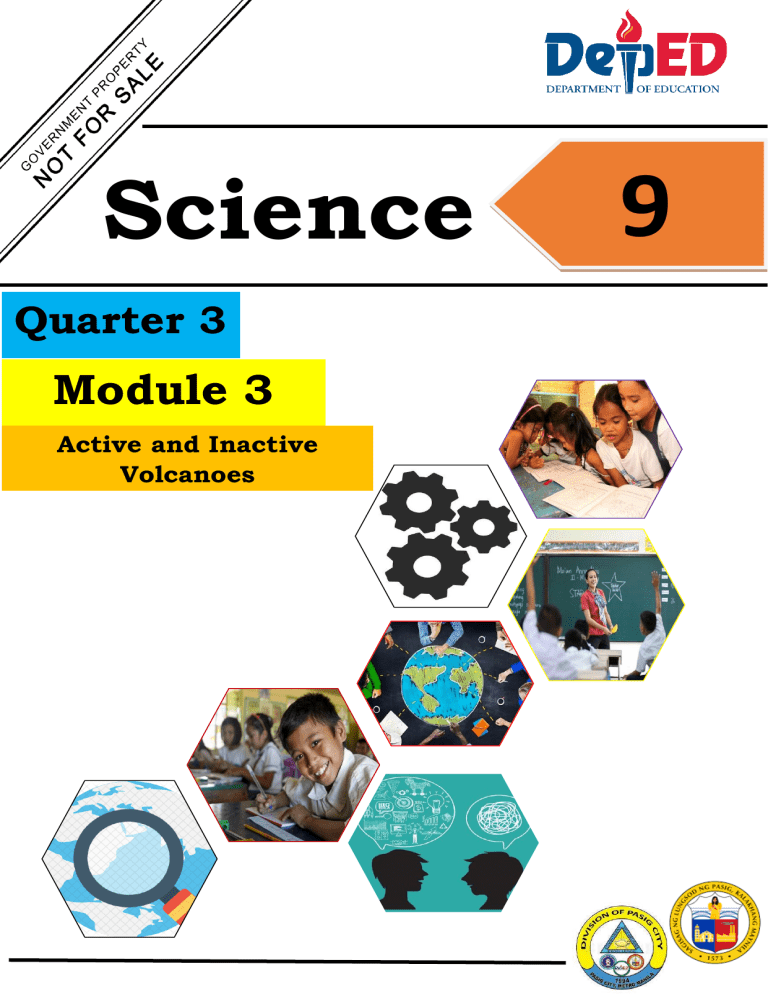
Science Quarter 3 3 Module 3 Active and Inactive Volcanoes 9 Science – Grade 9 Quarter – Module : Active and Inactive Volcano First Edition, 2020 Republic Act 8293, Section 176 states that no copyright shall subsist in any work of the Government of the Philippines. However, prior approval of the government agency or office wherein the work is created shall be necessary for exploitation of such work for profit. Such agency or office may, among other things, impose as a condition the payment of royalties. Borrowed materials (i.e., songs, stories, poems, pictures, photos, brand names, trademarks, etc.) included in this module are owned by their respective copyright holders. Every effort has been exerted to locate and seek permission to use these materials from their respective copyright owners. The publisher and authors do not represent nor claim ownership over them. Published by the Department of Education - Schools Division of Pasig City Development Team of the Self-Learning Module Writer: Flordeliza L. San Pedro Editor: Rosalina B. Piamonte Reviewers: Mylyn P. Gabriel Illustrator: Name Layout Artist: Jean Rean M. Laurente Management Team: Ma. Evalou Concepcion A. Agustin OIC-Schools Division Superintendent Carolina T. Rivera, CESE OIC-Assistant Schools Division Superintendent Manuel A. Laguerta, EdD Chief, Curriculum Implementation Division Education Program Supervisors Librada L. AgonEdD(EPP/TLE/TVL/TVE) Liza A. Alvarez(Science/STEM/SSP) Bernard R. Balitao(AP/HUMSS) Joselito E. Calios (English/SPFL/GAS) Norlyn D. CondeEdD(MAPEH/SPA/SPS/HOPE/A&D/Sports) Wilma Q. Del Rosario (LRMS/ADM) Ma. Teresita E. HerreraEdD(Filipino/GAS/Piling Larang) Perlita M. IgnacioPhD(EsP) Dulce O. Santos PhD(Kindergarten/MTB-MLE) Teresita P. TagulaoEdD(Mathematics/ABM) Printed in the Philippines by Department of Education –Schools Division of Pasig City Science 9 Quarter 3 Self Learnig Module 3 Active and Inactive Volcanoes Introductory Message For the Facilitator: Welcome to the Science 9 Self-Learning Module on Active and Inactive volcano. This Self-Learning Module was collaboratively designed, developed and reviewed by educators from the Schools Division Office of Pasig City headed by its Officer-inCharge Schools Division Superintendent, Ma. Evalou Concepcion A. Agustin, in partnership with the City Government of Pasig through its mayor, Honorable Victor Ma. Regis N. Sotto. The writers utilized the standards set by the K to 12 Curriculum using the Most Essential Learning Competencies (MELC) in developing this instructional resource. This learning material hopes to engage the learners in guided and independent learning activities at their own pace and time. Further, this also aims to help learners acquire the needed 21st century skills especially the 5 Cs, namely: Communication, Collaboration, Creativity, Critical Thinking, and Character while taking into consideration their needs and circumstances. In addition to the material in the main text, you will also see this box in the body of the module: Notes to the Teacher This contains helpful tips or strategies that will help you in guiding the learners. As a facilitator you are expected to orient the learners on how to use this module. You also need to keep track of the learners' progress while allowing them to manage their own learning. Moreover, you are expected to encourage and assist the learners as they do the tasks included in the module. For the Learner: Welcome to the Science 9 Self-Learning Module on Active and Inactive volcano. This module was designed to provide you with fun and meaningful opportunities for guided and independent learning at your own pace and time. You will be enabled to process the contents of the learning material while being an active learner. This module has the following parts and corresponding icons: Expectations – This points to the set of knowledge and skills that you will learn after completing the module. Pretest - This measures your prior knowledge aboutthe lesson at hand. Recap - This part of the module provides a review of concepts and skills that you already know about a previous lesson. Lesson - This section discusses the topic in the module. Activities - This is a set of activities that you need to perform. Wrap-Up - This section summarizes the concepts and application of the lesson. Valuing - This partintegrates a desirable moral value in the lesson. Posttest - This measures how much you have learned from the entire module. EXPECTATION In this module, we are going to tackle the two classifications of volcano— active, dormant and extinct. After going through this module, you are expected to: 1. differentiate active from inactive volcano; 2. give examples of active and inactive volcanoes found in the Philippines ; and 3. suggest ways on how to be prepare for volcanic eruption. PRE – TEST Choose the letter of the best answer. Write the chosen letter on a separate sheet of paper. 1. What is a dormant volcano? A. A volcano that erupts occasionally. B. A volcano that have erupted recently C. A volcano that will never erupt again. D. One that has not erupted in recorded history. 2.Volcanologist state that active volcanoes are those that had erupted in the last_____years. A. 1000 years C. 100,000 years B. 10,000 years D. 1,OOO,000 years 3. How will you classify volcanoes with no record of eruption? A. active B. inactive C. extinct D. dormant 4. Which of the following are active volcanoes? I. Mayon in Albay II. Taal in Batangas III. Vulcan in Camiguin IV. Kanlaon in Negros A. I and II only C. I, II and III only B. II and III only D. I, II and IV only 5. The following are precautionary measures when a volcanic eruptions occur EXCEPT ONE. A. close all windows, doors and other house openings B. cover your nose and mouth with mask to avoid breathing ashes C. prepare all necessary things such as food, medicine, water and clothing D. go to low-lying places as lahar and lava flows are more likely to run down through that area. RECAP Direction: Identify the different types of volcano .Write the letter before the number. A B C D ______1.Known as strato volcanoes, which has a steep sided cones formed from layers of ash and lava. ______2. A volcano that erupt quietly. ______3. A volcano which has a low with gently sloping sides and are formed from layers of lava. ______4.What type of volcano is label A. ______5.Has a steep cone-shaped hill formed by the eruptions of cinders and other rock fragments. LESSON Figure 1. Mt. Pinatubo Eruption Volcanic eruption is a natural phenomena which happens when lava and gas are discharged from a volcanic vent. Volcanic eruption can cause damages to properties, crops, and people. It is one of the most destructive calamity that could happen. Some of its common manifestations are ash fall, lahar, lava flow, ash cloud emissions or combination of those. One of the most destructive eruption that ever happened in the Philippines is the 1991 Mt. Pinatubo Eruption, which is caller as one of the most powerful and well-documented eruption of the 20th century. When it erupted last 1991, it spewed out 10 billion tons of magma and ash, and 20 million tons of sulfur dioxide. The resulting ash fall buried some parts of Pampanga under 10 feet of ash. This eruption is also said to cause a global cooling of temperature of about 0.5 degrees celsius. Our country has more than a hundred volcanoes as of 2013.There are several ways by which volcanoes can be classified. PHIVOLCS, have adapted a system where the Philippine volcanoes as Active or Inactive. Active Volcano An active volcano is a volcano that has had at least one eruption during the past 10,000 years. An active volcano might be erupting or dormant. An erupting volcano is an active volcano that is having an eruption... A dormant volcano is an active volcano that is not erupting, but supposed to erupt again. There are twenty-three active volcanoes in the country according to PHIVOLCS. List of Active Volcanoes in the Philippines Name of Volcano Province Babuyan Claro Babuyan Island Group, Cagayan in Luzon Banahaw Boundaries of Laguna and Quezon in Luzon Biliran (Anas) Leyte in Visayas Bud Dajo Sulu in Mindanao Bulusan Sorsogon, Bicol Region in Luzon Cabalian Southern Leyte in Visayas Cagua Cagayan in Luzon Camiguin de Babuyan Island Group, Cagayan in Luzon Babuyanes Didicas Babuyan Island Group, Cagayan in Luzon Hibok-Hibok Camiguin in Mindanao Iraya Batan Island, Batanes in Luzon Iriga Camarines Sur in Luzon Isarog Camarines Sur in Luzon Kanlaon Negros Oriental Leonard Kniaseff Davao del Norte Makaturing Lanao del Sur Matumtum Cotobato in Mindanao Mayon Albay, Bicol Region in Luzon Musuan ( Calayo) Bukidnon in Mindanao Parker South Cotobato/General Santos/ North Cotabato/Sarangani Provinces in Mindanao Pinatubo Boundaries of Pampanga, Tarlac and Zambales in Luzon Ragang Lanao del Sur and Cotobato in Mindanao Smith Babuyan Island Group, Cagayan in Luzon Taal Batangas in Luzon Inactive Volcano An inactive volcano is one that could erupt but has not erupted for more than 10,000 years. Inactive volcanoes are also called extinct or sleeping volcanoes. Inactive volcanoes are expected to erupt again at some point, despite being dormant for thousands of years. Volcanoes with no record of eruptions are considered as extinct or inactive. Their physical form since their last activity has been altered by agents of weathering and erosion with the formation of deep and long gullies. Inactive does not necessarily indicate the volcano will not erupt again. One example is Mount Pinatubo had no recorded historical eruption before its cataclysmic 1991 eruption. Some examples of inactive volcanoes in the Philippines Province Name of Volcano Anilao Hill Mt Batuan Mt. Urot Mt. Tamburok Mt. Cabaluyan Batangas Sorsogon Sulu Leyte Pangasinan ACTIVITIES Module 3: Activity No. 1 Active and Inactive Volcanoes Directions: Based on the given statements, determine if it described an active or inactive volcano. Description 1. No recorded of eruptions. 2. Having erupted within historical times. 3. There are 355 volcanoes with no record of activity, according to PHIVOLCS. 4. Having erupted within the last 10,000 years. 5. Mt. Mayon and Taal are some examples of these volcano. 6. There are 23 recorded volcanic activities in the Philippines 7. They are considered extinct. 8. Has not had an eruption for at least 10,000 years. 9. They are considered erupting or dormant. Active or Inactive 10. Mt. Urot and Batuan are some examples of these volcano. Guide Questions: 1. What is the difference between active from inactive volcano? __________________________________________________________________________________ 2. How do you know if the volcano is active? __________________________________________________________________________________ Closure: Can inactive volcanoes become active again? Module 3: Activity No. 2 Spot a Volcano Directions: Using the blank map below, locate and plot the volcanoes listed below. Materials Needed Colored Pencils or any coloring material Blank Philippine Map Ruler Procedure 1. Identify where in the Philippines does the following volcano can be located. 2. Plot the location of the following volcanoes found in Table 1. 3. Using coloring materials, draw a triangle on the location of these volcanoes. 4. Color these triangle based on the number of times it erupted as reflected above. Table 1. List of some volcanoes in the Philippines Volcano No. of Latest historical eruption or eruptions activity Cabaluyan 0 15 42 120 19 Cocoro 0 10 53 121 12 Iraya 1 1454 20 29 122 01 Kanlaon 26 2006 June 10 24 123 7 Mayon 49 2013 May 13 15 123 41 Pulung 0 7 55 124 38 Smith 6 1924 19 32 121 55 Taal 33 1977 14 120 59 Tamburok 0 11 33 124 26 Urot 0 5 59 121 15 Source: Philippines Institute of Volcanology and Seismology, accessed Sept. 30, 2013 Color Legend: latitude longitude 0 no record of eruptions 5-10 times- Green 10-15 times- Yellow 5-25- Orange 26 and above- Red 28° 27° 26° 25° 24° 23° 22° 21° 20° 19° 18° 17° 16° 15° 14° 13° 12° 11° 10° 9° 8° 7° 6° 5° 4° Guide Question: 1. Which of the volcanoes had the most number of eruptions? Least number of eruptions? No record of eruption? 2. How will you classify the volcanoes that have records of eruptions? 3. How will you classify volcanoes with no record of eruption? Closure: What is the most dangerous volcano in the Philippines? Why? WRAP – UP Make a concept map to distinguish Active from Inactive Volcano. Volcano Active Inactive • • • • • • VALUING Module 3; Activity No. 3 Be Prepared Undeniably, the Philippines is a home for many active volcanoes making the Philippines prone to volcanic eruption. Recently, Taal Volcano erupted causing massive ash fall on neighboring provinces which impose threats on public health. The government of Pasig City donated cash and food supplies to the Taal Volcano eruption victims. 1. As a student, what measures can you recommend to LGUs to minimize the effects of volcanic eruption? 2. When a volcano erupt, what preventive measures and precautions can you advise to those people living near a volcano? __________________________________________________________________________________ 3. After an eruption, what should people do especially those who are living on danger zones? __________________________________________________________________________________ POST-TEST Choose the letter of the best answer. Write the chosen letter on a separate sheet of paper. 1. Which of the following described an Inactive volcano? A. A volcano is that is having an eruption. B. A volcano might be erupting or dormant. C.A volcano that could erupt but has not erupted for more than 10,000 years D.A volcano that has had at least one eruption during the past 10,000 years. 2. What is the basis of classifying volcano as active or inactive? A. shape B. location C. style of eruption D. volcanic activity 3. The following are examples of active volcanoes in the Philippines EXCEPT ONE. A. Mt. Urot B. Mt. Taal C. Mt. Mayon D. Mt. Kanlaon 4. How many active volcanoes found in the Philippines, according to PHIVOLCS. A. 10 B. 15 C. 23 D. 5O 5. When a volcano erupt, what suggestion can you give to those people living near in the area. A. use a mask B. stay outdoor C. watch an ash fall Pretest: 1. D 2. B 3. B 4. A 5. D Recap: 1. Composite 2. Shield 3. Shield 4. Lava 5. Cinder Activity No.1 1. Inactive 2. Active 3. Inactive 6. Active 7. Inactive 8. Inactive 4. Active 5. Active 9. Inactive 10.Inactive Activity No. 2 KEY TO CORRECTION D. go to a near hot spring 2. D 1. C 3. A 4. C 5. A. Post Test: Answers vary. Activity No. 3 1. most number of eruption- Mayon, Kanlaon and Taal Least number of eruption- Mt Smith and Iraya No record of eruption- Mt, Cabaluyan. Cocoro, Pulung,Urot and Tamburok 2. Active 3. Inactive Guide Question: REFERENCES Electronic Sources https://www.ifrc.org/en/what-we-do/disaster-management/aboutdisasters/definition-of-hazard/volcanic-eruptions/ https://www.esquiremag.ph/long-reads/most-destructive-volcanic-eruptions-inphilippine-history-a00293-20200125-lfrm https://sciencing.com/classification-volcanoes-8442589.html https://www.google.com/amp/s/www.traveling-up.com/active-volcanoes-in-thephilippines/amp/

